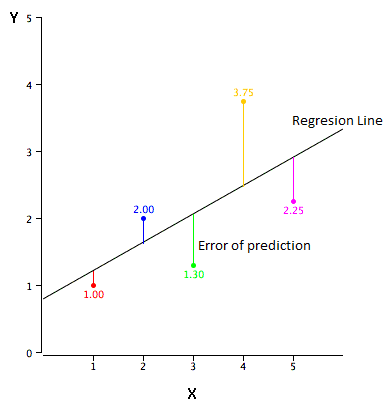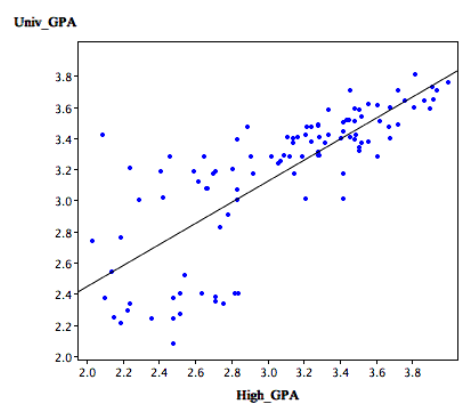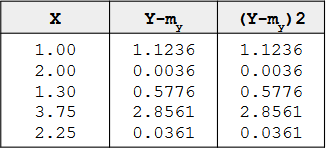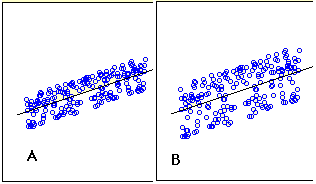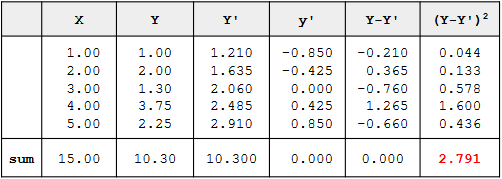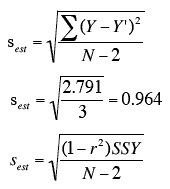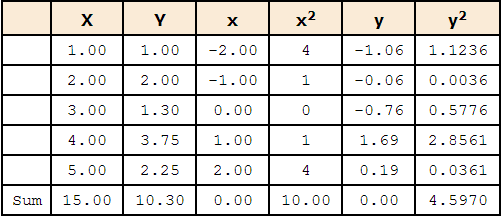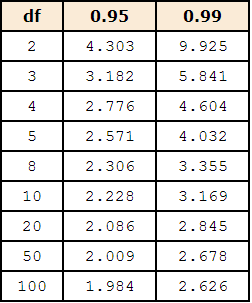Prediction
<slideshow style="nobleprog" headingmark="。" incmark="…" scaled="false" font="Trebuchet MS" >
- title
- Regresssion
- author
- Yolande Tra
</slideshow>
Introduction to Simple Linear Regression。
Simple Regression
In simple linear regression, we predict scores on one variable from the scores on a second variable.
- Criterion variable: The variable we are predicting, referred to as Y.
- Predictor variable: The variable we are basing our predictions on, referred to as X.
When there is only one predictor variable, the prediction method is called simple regression
- In simple linear regression, the predictions of Y when plotted as a function of X form a straight line.
Simple Regression Example。
Data in the table are plotted in the graph below.
- there is a positive relationship between X and Y.
- If you were going to predict Y from X,
- the higher the value of X, the higher your prediction of Y.
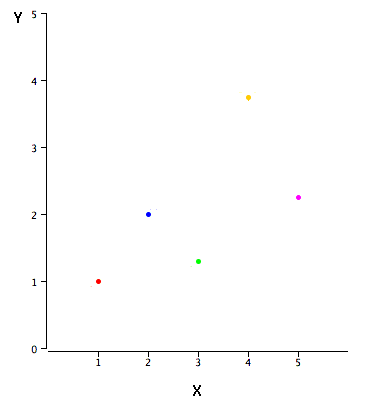
|
X | Y |
|---|---|---|
| 1.00 | 1.00 | |
| 2.00 | 2.00 | |
| 3.00 | 1.30 | |
| 4.00 | 3.75 | |
| 5.00 | 2.25 |
Linear regression。
- Linear regression consists of finding the best-fitting straight line through the points.
- The best-fitting line is called a regression line
- Example
Regression Line。
The error of prediction
The error of prediction for a point is the value of the point minus the predicted value (the value on the line)
- Example
- the predicted values (Y') and the errors of prediction (Y-Y').
- the first point has a Y of 1.00 and a predicted Y of 1.21. Therefore its error of prediction is -0.21.
| X | Y | Y' | Y-Y' | (Y-Y')2 |
|---|---|---|---|---|
| 1.00 | 1.00 | 1.210 | -0.210 | 0.044 |
| 2.00 | 2.00 | 1.635 | 0.365 | 0.133 |
| 3.00 | 1.30 | 2.060 | -0.760 | 0.578 |
| 4.00 | 3.75 | 2.485 | 1.265 | 1.600 |
| 5.00 | 2.25 | 2.910 | -0.660 | 0.436 |
Regression Line。
The Best Fitting Line
- What does it meant by "best fitting line" ?
- By far the most commonly used criterion for the best fitting line is the line that minimizes the sum of the squared errors of prediction.
- That is the criterion that was used to find the line in previous regression line graph.
- The last column in the previous table shows the squared errors of prediction.
- The sum of the squared errors of prediction shown in the previous table is lower than it would be for any other regression line.
The Formula for a Regression Line。
The formula for a regression line
Y' = bX + A where Y' is the predicted score, b is the slope of the line, and A is the Y intercept.
- Example
The equation for the line in the previous graph is
- Y' = 0.425X + 0.785
- For X = 1, Y' = (0.425)(1) + 0.785 = 1.21
- For X = 2, Y' = (0.425)(2) + 0.785 = 1.64
Computing the Regression Line。
- In the age of computers, the regression line is typically computed with statistical software.
- However, the calculations are relatively easy are given here for anyone who is interested.
The calculations are based on the statistics below.
- MX is the mean of X
- MY is the mean of Y
- sX is the standard deviation of X
- sY is the standard deviation of Y
- r is the correlation between X and Y
| MX | MY | sX | sY | r |
|---|---|---|---|---|
| 3 | 2.06 | 1.581 | 1.072 | 0.627 |
The Slope of the Regression Line。
The slope (b) can be calculated as follows:
b = r sY/sX
and the intercept (A) can be calculated as
A = MY - bMX
For these data,
b = (0.627)(1.072)/1.581 = 0.425 A = 2.06 - (0.425)(3)=0.785
- The calculations have all been shown in terms of sample statistics rather than population parameters.
- The formulas are the same; simply use the parameter values for means, standard deviations, and the correlation.
Standardized Variables。
- The regression equation is simpler if variables are standardized so that their means are equal to 0 and standard deviations are equal to 1, for then b = r and A = 0.
- This makes the regression line:
ZY' = (r)(ZX) where ZY' is the predicted standard score for Y, r is the correlation, and ZX is the standardized score for X.
Note that the slope of the regression equation for standardized variables is r.
Example。
The case study, Predicting GPA contains high school and university grades for 105 computer science majors at a local state school.
- We now consider how we could predict a student's university GPA if we knew his or her high school GPA.
- The correlation is 0.78 The regression equation is
GPA' = (0.675)(High School GPA) + 1.097
- A student with a high school GPA of 3 would be predicted to have a university GPA of
GPA' = (0.675)(3) + 1.097 = 3.12
- The graph shows University GPA as a function of High School GPA
- There is a strong positive relationship between them
Assumptions。
- It may surprise you, but the calculations shown in this section are assumption free.
- Of course, if the relationship between X and Y is not linear, a different shaped function could fit the data better.
- Inferential statistics in regression are based on several assumptions.
Quiz。
Partitioning Sums of Squares。
One useful aspect of regression is that it can divide the variation in Y into two parts:
- the variation of the predicted scores
- the variation in the errors of prediction
The variation of Y
- the sum of squares Y
- defined as the sum of the squared deviations of Y from the mean of Y
Formula of the Variation of Y。
In the population, the formula of The variation of Y
 where SSY is the sum of squares Y and
Y is an individual value of Y, and my is the mean of Y
where SSY is the sum of squares Y and
Y is an individual value of Y, and my is the mean of Y
Example。
The mean of Y is 2.06 and SSY is the sum of the values in third column and is equal to 4.597
When computed in a sample, you should use the sample mean, M, in place of the population mean.
Example。
- The column Y' were computed according to this equation.
- The column y' contains deviations of Y' from the mean Y'
- The column y'2 is the square of this column.
- The column Y-Y' contains the actual scores (Y) minus the predicted scores (Y')
- The column (Y-Y')2 contains the squares of these errors of prediction
Sum of the squared deviations from the mean 。
SSY is the sum of the squared deviations from the mean.
- It is therefore the sum of the y2 column and is equal to 4.597.
- SSY can be partitioned into two parts:
- 1. the sum of squares predicted (SSY')
- The sum of squares predicted is the sum of the squared deviations of the predicted scores from the mean predicted score.
- In other words, it is the sum of the y'2 column and is equal to 1.806
- 2.the sum of squares error (SSE)
- The sum of squares error is the sum of the squared errors of prediction.
- It is there fore the sum of the (Y-Y')2 column and is equal to 2.791.
- This can be summed up as:
SSY = SSY' + SSE 4.597 = 1.806 + 2.791
Example。
- The sum of y and the sum of y' are both zero
- This will always be the case because these variables were created by subtracting their respective means from each value.
- The mean of Y-Y' is 0
- This indicates that although some Y's are higher than there respective Y's and some are lower, the average difference is zero.
SSY is the total variation SSY' is the variation explained SSE is the variation unexplained
Therefore, the proportion of variation explained can be computed as:
Proportion explained = SSY'/SSY
Similarly, the proportion not explained is:
Proportion not explained = SSE/SSY
r2。
There is an important relationship between the proportion of variation explained and Pearson's correlation:
- r2 is the proportion of variation explained
Therefore,
- if r = 1, then the proportion of variation explained is 1
- if r = 0, then the proportion explained is 0;
- if r = 0.4, then the proportion of variation explained is 0.16
Since the variance is computed by dividing the variation by N (for a population) or N-1 (for a sample), the relationships spelled out above in terms of variation also hold for variance
Example
- the first term is the variance total
- the second term is the variance of Y'
- the last term is the variance of the errors of prediction (Y-Y')
Similarly, r2 is the proportion of variance explained as well as the proportion of variation explained.
Summary Table。
It is often convenient to summarize the partitioning of the data in a table.
- The degrees of freedom column (df) shows the degrees of freedom for each source of variation.
- The degrees of freedom for the sum of squares explained is equal to the number of predictor variables.
- This will always be 1 in simple regression.
- The error degrees of freedom is equal to the total number of observations minus 2.
- In this example, it is 5 - 2 = 3.
- The total degrees of freedom is the total number of observations minus 1.
| Source | Sum of Squares | df | Mean Square |
|---|---|---|---|
| Explained | 1.806 | 1 | 1.806 |
| Error | 2.791 | 3 | 0.930 |
| Total | 4.597 | 4 |
</>
Quiz
The standard error of the estimate。
The standard error of the estimate
- is closely related to this quantity and is defined below:
- is a measure of the accuracy of predictions
 sest is the standard error of the estimate,
Y - actual score
Y' - predicted score
Y-Y' - differences between the actual scores and the predicted scores.
Σ(Y-Y')2 - SSE
N - number of pairs of scores
sest is the standard error of the estimate,
Y - actual score
Y' - predicted score
Y-Y' - differences between the actual scores and the predicted scores.
Σ(Y-Y')2 - SSE
N - number of pairs of scores
Simple Example
- The graphs below shows two regression examples.
- You can see that in graph A, the points are closer to the line then they are in graph B.
- Therefore, the predictions in Graph A are more accurate than in Graph B.
Example。
Assume the data below are the data from a population of five X-Y pairs
- The last column shows that the sum of the squared errors of prediction is 2.791.
- Therefore, the standard error of the estimate is:
Formula for the Standard Error
There is a version of the formula for the standard error in terms of Pearson's correlation:
where ρ is the population value of Pearson's correlation
SSY is
Similar formulas are used when the standard error of the estimate is computed from a sample rather than a population.
- The only difference is that the denominator is N-2 rather than N, since two parameters (the slope and the intercept) were estimated in order to estimate the sum of squares
- Formulas comparable to the ones for the population are shown below.
Example。
For the example data,
- μy = 2.06
- SSY = 4.597
- ρ= 0.6268.
Therefore,
which is the same value computed previously. </>
Quiz
Inferential Statistics for b and r。
Assumptions
- Although no assumptions were needed to determine the best-fitting straight line, assumptions are made in the calculation of inferential statistics.
- Naturally, these assumptions refer to the population, not the sample.
- Linearity: The relationship between the two variables is linear.
- Homoscedasticity: The variance around the regression line is the same for all values of X. A clear violation of this assumption is shown in below. (Notice that the predictions for students with high high-school GPAs are very good, whereas the predictions for students with low high-school GPAs are not very good. In other words, the points for students with high high-school GPAs are close to the regression line, whereas the points for low high-school GPA students are not.)
- The errors of prediction are distributed normally. This means that the deviations from the regression line are normally distributed. It does not mean that X or Y is normally distributed.
Significance Test for the Slope (b)
As applied here, the statistic is the sample value of the slope (b) and the hypothesized value is 0.
- The number of degrees of freedom for this test is
df = N-2 where N is the number of pairs of scores.
- The estimated standard error of b is computed using the following formula
 sb is the estimated standard error of b,
sest is the standard error of the estimate
SSX is the sum of squared deviations of X from the mean of X
sb is the estimated standard error of b,
sest is the standard error of the estimate
SSX is the sum of squared deviations of X from the mean of X
- SSX is calculated as
 where Mx is the mean of X
where Mx is the mean of X
- The standard error of the estimate can be calculated as

Example。
- The column X has the values of the predictor variable
- The column Y has the values of the criterion variable
- The column x has the differences between the values of column X and the mean of X
- The column x2 is the square of the x column
- The column y has the differences between the values of column Y and the mean of Y.
- The column y2 is simply square of the y column
- The standard error of the estimate
The computation of the standard error of the estimate (sest) for these data is shown in the section on the standard error of the estimate. It is equal to 0.964.
sest = 0.964
- SSX
SSX is the sum of squared deviations from the mean of X. i.e. it is equal to the sum of the x2 column and is equal to 10.
SSX = 10.00
We now have all the information to compute the standard error of b:
- the slope (b) is
b= 0.425. df = N-2 = 5-2 = 3.
- The p value for a two-tailed t test is 0.26.
- Therefore, the slope is not significantly different from 0.
Confidence Interval for the Slope。
- The method for computing a confidence interval for the population slope is very similar to methods for computing other confidence intervals.
- For the 95% confidence interval, the formula is:
lower limit: b - (t.95)(sb) upper limit: b + (t.95)(sb) where t.95 is the value of t to use for the 95% confidence interval
Example。
- The values of t to be used in a confidence interval can be looked up in a table of the t distribution.
- A small version of such a table is shown above.
- The first column, df, stands for degrees of freedom.
- You can also use the "inverse t distribution" calculator to find the t values to use in a confidence interval.
- Applying these formulas to the example data,
lower limit: 0.425 - (3.182)(0.305) = -0.55 upper limit: 0.425 + (3.182)(0.305) = 1.40
Significance Test for the Correlation。
The formula for a significance test of Pearson's correlation is shown below:
 where N is the number of pairs of scores.
where N is the number of pairs of scores.
For the example data,

Notice that this is the same t value obtained in the t test of b. As in that test, the degrees of freedom is
N - 2 = 5 -2 = 3.
Quiz
